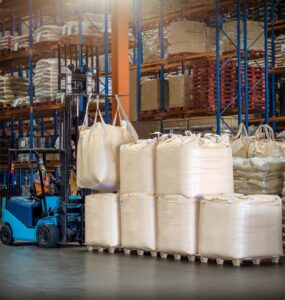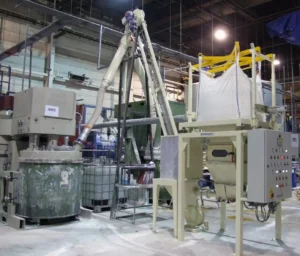Spiroflow, a worldwide leader in bulk bag handling for transportation and storage, offers solutions from conveying to bulk bag filling and bulk bag unloading systems to end-of-line robotic palletizing. The easiest method of transporting bulk bags is on pallets (or skid sheets) using a forklift or pallet truck.
Bulk Bag Handling for Transportation and Storage Considerations
The ideal size of the pallet is large enough so that the rounded section of the bulk bag does not overlap the edges of the pallet. When the two palletized bulk bags are placed side by side, the bags must not touch. This will minimize the risk of damage to the bag and greatly assist in the stability of the bulk bags in stacking and inside trailers and containers.
Pallet Shape and Bulk Bag Alignment
As most pallets are rectangular in shape, this is not always an easy task if you are using a square-based bulk bag. The ability to locate the bulk bag centrally on the pallet, especially after filling, is critical. There is a wide range of mechanical devices available to assist the fork truck driver, plus utilizing the side shift on the forklift truck itself will help.
Stacking Considerations and Pallet Design
If bulk bags will be stacked, the pallets need to be closely slatted on both the top and bottom to stop “pinching” of the bag. The bulk bag must not protrude through the slats of the pallet above, or they will be damaged by the fork tines when unstacking the bags. Close-slatted pallets also give much greater stability in the stack, which reduces damage and time in unstacking and, generally, makes it easier for the fork truck driver.
Pallet Choices for Shipping and In-Plant Use
Close-slatted pallets are costly and may only be financially justified for in-plant use unless their return can be guaranteed. For shipping out, the bags can be transferred to a non-returnable pallet. Two bulk bags can also be placed on top of each other on one pallet for trailer or containerized shipment as long as the filled height of the bulk bag is less than 42 inches. This is a labor-intensive process and must be considered as part of a costing exercise. If stacking isn’t needed, then standard single-trip pallets can be used. However, one must factor in the risk of damage to the filled bulk bags on poorly constructed pallets by fork tines.
Skid Sheet Handling
If the plant handling the bulk bags already has skid sheet handling facilities available, these can be used instead of pallets with certain caution. When stacking with skid sheets, stability is reduced. We do not advise three high stacking for bulk bags with a filled height in excess of 40 inches or two high stacking for bags with a filled height of more than 54 inches. Racking should be considered for bulk bags taller than those noted above. The same caution concerning pallets and bag sizing applies to skid sheets.
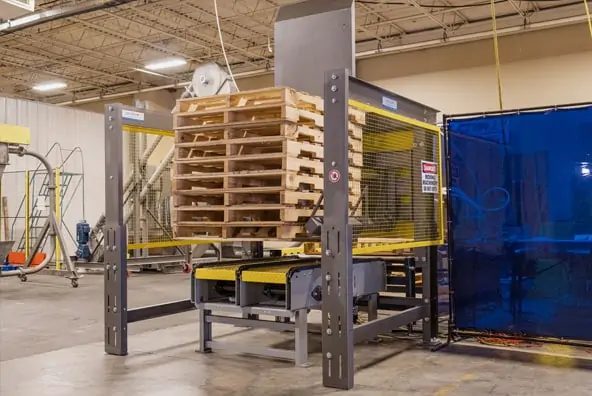
Well-filled Bulk Bags are Essential for Safety, Storage and Transport
Well-filled bulk bags that have been properly sized are stable and safe to handle and stack. What constitutes a well-fitted bulk bag is discussed below, but stability must be retained not just after filling but during stacking, unstacking, transportation, and restacking.
To do this, a good fork truck driver should always try to restack bulk bags in the same sequence that they were originally stacked. The bottom bag, which is more compressed, will best be re-positioned at the bottom of the new stack or be part of the lower tier in a trailer/container where double stacking can be achieved.
Bulk bags that lean to one side or become banana-shaped cannot be corrected once filled. They are dangerous and expensive to handle. Bulk bags that contain aerated ingredients that have not been deaerated during or after filling are unstable, dangerous, and expensive to handle. Such ingredients tend to be those that have fluidizing air entrained in the material prior to filling. The air must be removed if the filled bulk bag is to remain stable. This applies particularly to powdered ingredients.
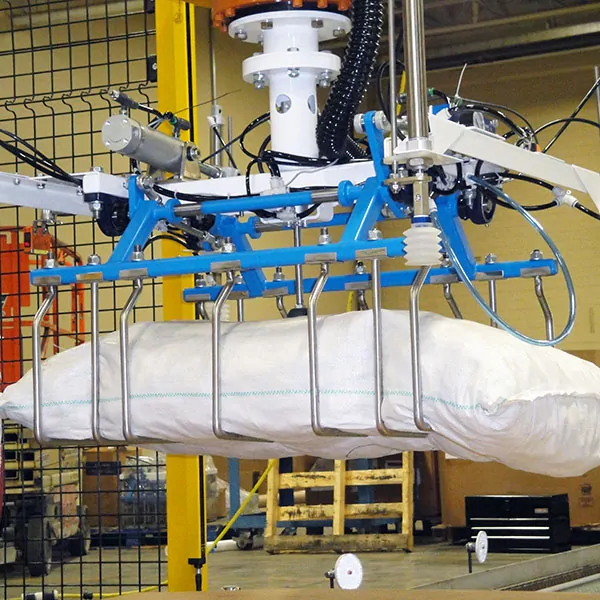
Transporting Materials in Bulk Bags
The use of bulk bags to transport minerals, chemicals, grain, and other dry solids by sea rather than in ISO Containers is a growing market. Lower shipment costs and the ability to ship value-added products not suitable for packaging are becoming popular, particularly with end-users who are unable to receive bulk shipments. There are several points worth noting before planning this method of shipment:
- Bulk bags require loading and unloading “on the hook.” This means that the choice of vessel is important. Wide hatches and small wing spaces with minimum flaring in the forward hold will enable the bulk bags to be loaded and unloaded by a ship’s crane or dockside cranes without moving the bulk bags into the corners of the hold by fork truck.
- Stacking bulk bags in the ship’s hold without pallets requires using a correctly sized crane spreader bar so that the bags are touching when lifted over the ship’s side and that the loops are vertical.
- Bulk bags for this type of shipment usually have loop extenders added to the lifting loops to enable the four loops to meet in the center for single hook pick-up. Tying the loop extenders together with elastic assists the stevedores at unloading time and, therefore, a reduction in damage costs.
- It is worth the extra bag cost to ensure that the quality and weight of cloth used in the make-up of the bulk bag is increased slightly higher than normal as this will reduce the chance of damage at the docks where rough handling is usually encountered. Some overseas ports reject poor-quality bags or unsafely filled bulk bags.
Handling Bulk Bags at Discharge
To discharge a bulk bag, it must be lifted into a bulk bag discharger. Therefore, it is advisable to ensure that the bulk bag to be discharged is located within reach of the bulk bag discharger hoist or fork truck fitted with a lifting frame. Lifting frames are devices to which the bulk bag lifting loops can be attached so that the lifting loops are kept vertical.
These lifting frames can be made for hoist or fork truck use. They are usually supplied as part of any bulk bag discharger and should be made to suit the size of the bulk bag being discharged. It is bad practice to allow operators to stand under a hanging bag when it is being hoisted, and a well-designed bulk bag discharger should allow an operator to discharge the bag without ever standing under the hanging bag.
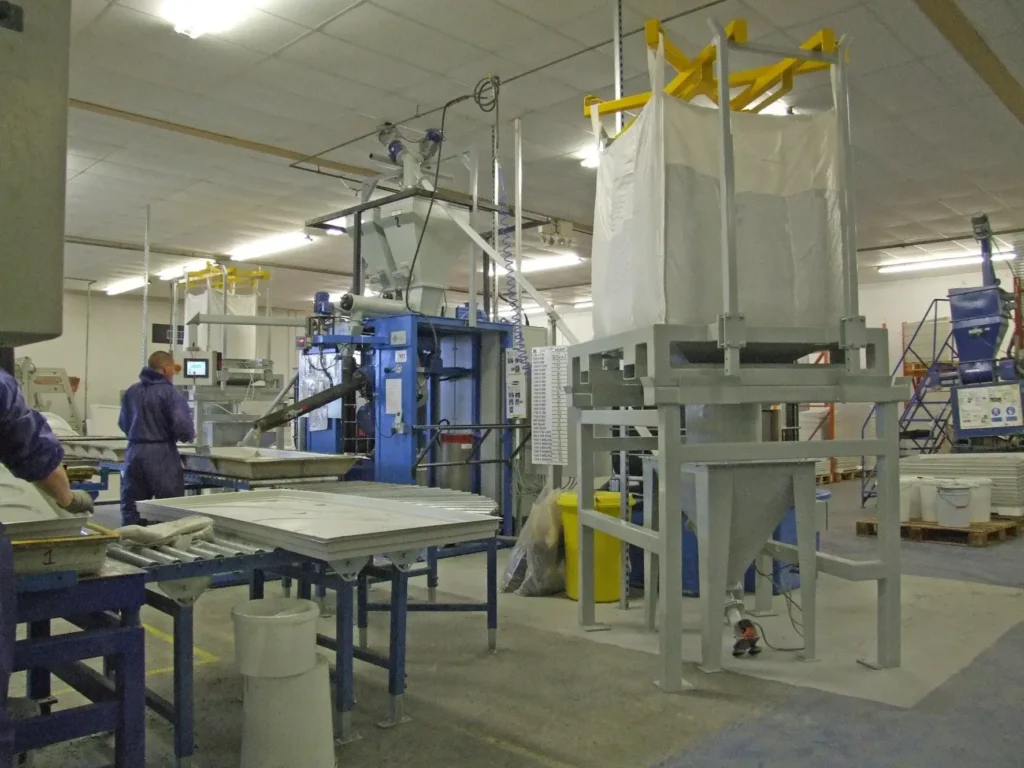
Innovative Bulk Bag Handling and Advanced Conveyor Solutions at Spiroflow
At Spiroflow, we specialize in high-containment bulk bag filling and bulk bag unloading systems – offering the most comprehensive range of standard and custom solutions in the business. Our expertise extends to a variety of conveyor solutions, including flexible screw conveyors and advanced conveyor belt systems, tailored to meet the unique needs of our clients.
Our product lineup includes industrial conveyor systems designed for efficiency and reliability. Whether you’re looking for conveyor belt solutions for small-scale operations or large industrial applications, we have the right equipment for you. Our conveyor systems manufacturers are committed to delivering quality and precision in every product.You can call us today at 704-246-0900, contact us, or email directly sales@spiroflow.com. We look forward to helping you find the right bulk bag handling solution!



